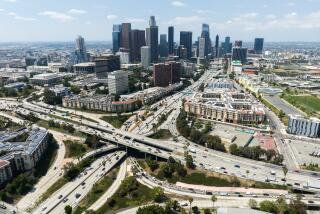No Mass Transit System Can Defy Society’s Trends
- Share via
If MTA is to succeed, it must look to L.A. region’s needs Los Angeles is one of the few places where people pick up a newspaper or turn to television or radio avid for the news about local mass transit. Now, the latest in a nearly unbroken string of “Oh gosh, what have they done now?” stories involves a second, stunning federal rejection of the MTA’s long-range transit plans.
In sum, the present situation is a product of larger events, bad luck, poor planning, screwball regional politics and egregiously bad management. A little history is in order.
The Sacramento-born Metropolitan Transportation Authority was preceded by two other incarnations, also established by the Legislature. One, the Southern California Rapid Transit District, was best known for employees who showed up about as regularly as truant students. The addition of the Los Angeles County Transportation Commission in 1976 merely provided more colorful distractions as the two agencies viciously fought for power and influence. In fact, the MTA was just the forced merger of warring factions, with the same old alliances and rivalries represented on the board.
Next, the massive bus and rail plan originally embraced by the new MTA ignored almost every national and international demographic and political trend. It was to be built at a time when federal transit spending, in constant dollars, was in sharp decline. Los Angeles had waited too long to develop its transit system. And a later unforeseen occurrence, the end of the Cold War, was good for the world but bad for rail transit planning in Los Angeles. The dissolution of this area’s massive defense/aerospace industry also made obsolete rail line plans to ferry workers to those jobs. Moreover, the old “drive to work downtown and then back home” pattern had been a ghost for years. The new Los Angeles economy is based on the entertainment industry (which had been ignored in the transit plans) and widely dispersed small businesses. Almost everyone now has to make more side trips on the way home: day care center, children’s sporting events, dry cleaners. That only increases reliance on personal vehicles.
There was no indication that the RTD or LACTC or MTA understood the history of mass transportation in the United States. Ridership has always followed external events; it was highest during the two world wars and has not come close to those peaks again. People use mass transit because they have to or because it is more convenient than driving. To be sure, there’s no need to do a selling job on the transit-dependent poor (most of whom long for the day when they can afford a car), but it costs plenty to lure higher-income people. When the MTA emphasized the latter, the authority found itself facing a lawsuit charging that poor bus riders were being exploited in an effort to subsidize little-used rail routes.
Other trends were equally important. Rail is still a force, but the big transit growth nationwide has been in “demand response” vehicles. Smaller than city buses and without fixed routes, these vehicles are dispatched to take passengers to specific destinations. Now, it will take aggressive development near rail and subway stops to make the rail investment pay off here.
Finally, the MTA board consists of local officeholders, and prudent management appears subordinate to getting a slice of the pie for constituents. If Sacramento wants real change, it might consider a board composed of elected local officials in their final term, ideally with no interest in higher office (we can dream), along with acknowledged experts in the field. Anything less figures to preserve the MTA’s hard-earned reputation for comic relief.
(BEGIN TEXT OF INFOBOX / INFOGRAPHIC)
Transit Aid
The decline of federal transit funding in current dollars.
Source: Department of Transportation appropriations acts
More to Read
Sign up for Essential California
The most important California stories and recommendations in your inbox every morning.
You may occasionally receive promotional content from the Los Angeles Times.










